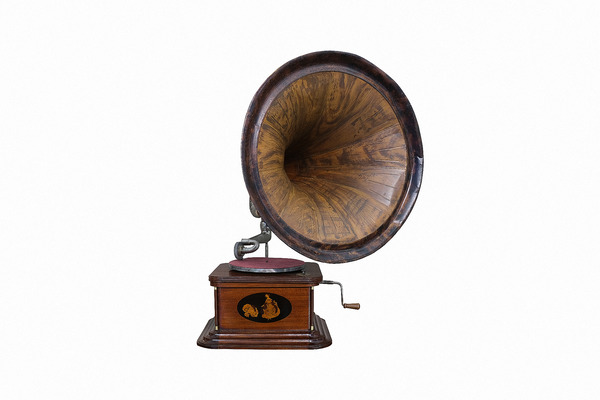A gramophone is an old mechanical device for reproducing sound. It is considered the successor of the very first recording device — the phonograph. The phonograph was invented by Thomas Edison, who introduced it to the public in 1877. In this device, the sound was recorded on a cylindrical carrier, while in the gramophone they began to use a flat disc that was easier to manufacture.
The mechanism of the device is similar to that of a clock. Its main task is to rotate a massive disk, on which a gramophone record is placed, evenly at a certain speed.
On the metal horn of the gramophone from the museum’s collection, there is a trademark “Pishushyi Amur” (Writing Cupid). It stands for the Russian branch of the Gramophone Company, which opened in Moscow. It was moved there from Riga in 1914 with the outbreak of the First World War.
Gramophones became an extremely popular commodity because the records could have musical sound recordings on them. People were delighted with the opportunity to listen to their favorite artists. The products captured the market instantly, and companies began to manufacture both mass-produced versions and rare collectible copies, for example, Monarch-Grand gramophones with horns made of pure silver of the 84th sample.
The mechanism of the device is similar to that of a clock. Its main task is to rotate a massive disk, on which a gramophone record is placed, evenly at a certain speed.
To do this, a powerful spiral spring is hidden inside a closed case. It is wound up with a special handle attached to a protruding axle. The number of springs in different gramophones varied — the duration of the disk rotation depended on them. The parts were made of high-grade steel because the springs required strong and elastic metal.
The horn was intended to amplify the sound. The strength and quality of the sound directly depended on its shape and material: it had to reflect sound waves well. At first, it was believed that the sound also depends on the size, so early gramophones were made with huge horns. Later, the researchers proved that this parameter was not important.
On the metal horn of the gramophone from the museum’s collection, there is a trademark “Pishushyi Amur” (Writing Cupid). It stands for the Russian branch of the Gramophone Company, which opened in Moscow. It was moved there from Riga in 1914 with the outbreak of the First World War.
The first gramophone and records for it were invented by the American Emil Berliner, who filed a patent in 1887. Six years later, the inventor formed the United States Gramophone Company in Washington. Then similar companies began to appear in other cities and countries. In England, the Gramophone was opened in 1899. In Russia, the company of the same name officially received permission to trade in 1903.
Gramophones became an extremely popular commodity because the records could have musical sound recordings on them. People were delighted with the opportunity to listen to their favorite artists. The products captured the market instantly, and companies began to manufacture both mass-produced versions and rare collectible copies, for example, Monarch-Grand gramophones with horns made of pure silver of the 84th sample.



